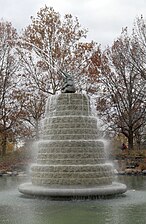Goodale Park
Located immediately north of downtown Columbus, the park is bordered by Goodale Street on the South, Park Street on the East, Buttles Avenue on the North, and Dennison Avenue on the West. Goodale Park features a pond, gazebo, tennis courts, a basketball court, bathrooms, and more.
The park contributes to the Near Northside Historic District, on the National Register of Historic Places.
History
Early history
The 37-acre site was donated by Dr. Lincoln Goodale on July 14, 1851, to be used as a public park or pleasure resort. He had originally purchased the property for railroads to gain access to the city. When the park opened in 1852 featuring a wooded grove of trees, it was the second largest municipal park in the country, the first at the time being Boston Common.
Camp Jackson during the Civil War

From April to June 1861, the park was used as a staging area for new recruits for the Union Army at the request of three city councilmen. The camp started in April when Governor William Dennison, at the urging of President Lincoln, called on Ohio communities to revive their militias and send them to Columbus.
"A high picket fence is erected around the camp, and the curious public mills around all day. Few visitors are allowed in. There are reports that the troops eat very well while in the camp."
The Governor's Guards, a corps of soldiers stationed at the camp, marched through Columbus on a Saturday morning to urge the local people to show their patriotism and enlist in the cause. A Captain Morrow was particularly successful: his company grew so large from new recruits that he started a second company, and was nearly able to fill that one as well. "Any young man interested in enlisting in this company, "B" of the 3rd Regiment, is told to call at Camp Jackson at an early hour."
In June, Camp Jackson's military operations are transferred to Camp Chase, 4 miles (6.4 km) west of Columbus, and Camp Jackson reverts to being a public park. During its peak, about 8,000 troops were stationed at the camp. Among the officers stationed at the camp were two future presidents: Rutherford B. Hayes and William McKinley.
Post-Civil War

After the Civil War, the park was under construction until 1875 for the creation of a carriage drive, landscaping inspired by Andrew Jackson Downing, and a lake house. Starting in 1874 during construction, the park exhibited various animals to draw children and their guardians to the park. In 1888, a bronze bust, the Lincoln Goodale Monument, was erected in the park commemorating Dr. Goodale's gift to the city.
From 1900 to the 1950s, the park faced multiple challenges for development, including a site for Memorial Hall, a Carneige Library, a branch library, and a bus garage. In July 1910, the park once again hosted troops when the Ohio National Guard was called in to quell a streetcar strike when it looked to turn violent. The troops stayed for two weeks and after their departure, the worst violence of the strike erupted.
In the 1970s and 1980s, economic downturn negatively affected the park, making it unsafe and unmaintained. In the mid-1980s, the Columbus Recreation and Parks Department began installing train tracks in the park (from a former Columbus Zoo train) and neighbors reacted and began organizing to have a say in the park's direction. In 1987, the Friends of Goodale Park was officially formed to maintain and preserve the park. In 2004, they began the restoration of the Goodale Gates, erected during the park's time as Camp Jackson.
Park amenities
Park facilities include ball diamonds, basketball courts, gardens, a gazebo, playground, shelterhouses and tennis courts. The shelterhouse and gazebo both have Victorian-style architecture. The park is home to two Champion Trees: a Chinese catalpa and Smoothleaf elm.
Gallery
-
Pond and gazebo
-
Fountain
-
Arched entranceway
-
Charles Benton Flagg Memorial
See also
References
- ^ "Facility: Goodale Park". Columbus Recreation & Parks Department. Retrieved February 22, 2012.
- ^ "Goodale Park". Geographic Names Information System. United States Geological Survey, United States Department of the Interior. Retrieved February 22, 2012.
- ^ Mullet Randall, Beverly (March 2007). "Dr. Lincoln Goodale and His Living Legacy Part Four: Goodale Park: A Brief History from the Beginning through the Civil War Years". Short North Gazette, Columbus, Ohio. Retrieved June 19, 2012.
- ^ National Register of Historic Places Registration Form. File Unit: National Register of Historic Places and National Historic Landmarks Program Records: Ohio, 1964 - 2013. National Park Service. Retrieved January 8, 2021.
- ^ "Goodale Park". www.columbus.gov. Retrieved 2022-02-10.
- ^ Betti, Tom; Lentz, Ed; Sauer, Doreen Uhas (2013-10-01). Columbus Neighborhoods: A Guide to the Landmarks of Franklinton, German Village, King-Lincoln, Olde Town East, Short North & the University District. Arcadia Publishing. ISBN 978-1-62584-656-3.
- ^ "Camp Chase - Ohio History Central".
- ^ Seifert, Mark (March 6, 1977). "Goodale Left His Mark". login.webproxy3.columbuslibrary.org. Columbus Dispatch. pp. 285–286. Retrieved 2022-02-23.
- ^ Taggart, Nick (2020). Short North Neighborhood. Arcadia Publishing. ISBN 978-1-4671-0456-2.
- ^ "Friends of Goodale Park". www.shortnorth.com. Retrieved 2022-02-12.
- ^ "Goodale Park Gates". Ohio History Connection. Retrieved February 10, 2022.
- ^ "Goodale Park facilities to get upgrade". www.bizjournals.com. October 14, 2020. Retrieved 2022-02-17.



